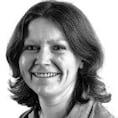“I thought you were coming to me with a miracle cure,” jokes 72-year-old Joe McPartlin as he lies in his bed, chatting to Dr Lucy Balding, medical director of Our Lady’s Hospice in Harold’s Cross, Dublin.
“I can’t fix the cancer. I can only fix the symptoms that it is giving you,” says Balding, as she gently places her hand on his arm while sitting on a low stool close to his bed.
The Irish Times has been invited to join the medical team on a ward round and McPartlin, a biochemist and former director of the Trinity Translational Medicine Institute at St James’s Hospital, has acquiesced to the journalist sitting in on this difficult conversation about his prognosis.
Other members of the medical team listen carefully and respectfully as McPartlin asks intelligent questions and digests the painful reality that his cancer is incurable and the task in hand now is to make him as comfortable as possible through symptom relief and psychological support.
READ MORE
“This is going to be a waiting game for me now. I’ve no pain at the moment and no symptoms apart from the dry retching, nausea and fatigue,” he says.
Responding to his need for physical support at this time, Balding says, “it goes against the grain for someone like you, who is used to being independent, to ask for help. But call the nurse to assist you to go to the bathroom.”
She also nods in agreement when he says he needs his visitors to stay for shorter periods of time. “People who know me best understand this, but it’s those who come infrequently who don’t know how long to stay,” he says.
McPartlin reflects on his journey with metastatic colorectal cancer. “After my diagnosis and when I was going for the second round of chemo, I hadn’t made up my mind to face death. Then, not so long ago, I thought, I’ve had a good life, a great life really. I’ve had family and friends and a lot to be grateful for. But I’d still rather live,” he says, with tears in his eyes.
Purposefully lifting the mood in the room, he then tells us how he has scored himself over 75 per cent on having so few of the five commonest regrets.
“I have lots of really good friends; I didn’t work too hard; I could have expressed my feeling more, but I tried to be honest with people,” says McPartlin, who is divorced with two adult daughters. He also speaks frankly about going with his brother to choose his burial plot close to his parents in Glasnevin Cemetery.
The children are so accepting. We’ve had to have tough conversations with them about what a hospice is. But they see how well he is cared for
— Caroline Clifford
Balding seems comfortable having these conversations, steering patients to face their emotions yet gently allaying their fears of pain. “I don’t think I’ll be overwhelmed, unless the pain becomes unmanageable,” says McPartlin as he asks her what to expect.
“The change in energy is the thing. You’ll spend more and more time resting. I think you’ve a number of weeks rather than days ahead of you,” she says, to which he quietly replies: “That sounds not unexpected.”
We move on into a room with a wall full of photographs of a smiling couple with their three children out on hikes. There are also drawings on the wall and a music system which is often streaming songs into the space.
[ Inside the Hospice: ‘Most have regrets... sometimes very sad regrets’Opens in new window ]
Caroline Clifford sits quietly beside the bed as her husband, 40-year-old Brian Clifford, sleeps. She comes in every day and then is back again in the evening when their children, Daniel (11), Lucie (8) and Sam (3) are in bed. The children are regular visitors, as are his friends, one of whom brings in his dog.
It’s very sad to witness this seemingly strong-bodied man, who suffered a brain tumour 10 years ago, near the end of his life.
“I had never been in a hospice before,” says Clifford, referring to Brian’s move to the hospice from St Vincent’s hospital in July. “As soon as we came here we started to feel calm. I never leave worried. Everything is noticed and managed.”
Clifford, a set designer with RTÉ who is currently on leave, says: “The children are so accepting. We’ve had to have tough conversations with them about what a hospice is. But they see how well he is cared for. It was a big decision not to continue being in the hospital. I was really nervous, but as soon as you come in the door, it’s calm. We’ve got some time back since we arrived here. It’s very precious. And I feel completely supported every single day.”
She explains how her husband has had nine surgeries and several rounds of chemotherapy and radiotherapy. “He never let it stop him doing anything. We went all over Ireland,” she says. A former chef, Brian completed a psychology degree at the Ulster University and was midway through his PhD when he was diagnosed.
“He became a stay-at-home dad and gave so much to the children,” says Clifford.
“Hospices exist for families like Brian’s,” says Balding as we leave the room, leaving Clifford sitting beside her sleeping husband.
Patricia Torrez welcomes us into her room with a serene smile. Of the three patients we meet, the 46-year-old emanates a strong sense of acceptance of her imminent death. The medical team says she is very ill and their job is to keep her as comfortable as possible, with continuous infusions of medicines delivered via a pump to alleviate her pain.
[ Life in a hospice: ‘Everything is done. The plot is bought’Opens in new window ]
Originally from Bolivia, Torrez moved to Ireland with her husband Fidel and their two sons, Patrick (16) and Josafat (11) three years ago. Her sister and mother arrived from Bolivia a few days before our meeting to spend time with her.
“I’m very grateful for all the care I’m getting here and I’m happy to have my mother and sister here for my boys,” she says.
“It’s all about her getting quality time with her boys now,” says Aoife Coffey, the senior medical social worker who has been keeping in close contact with the school the boys attend.
After the ward round, Balding tells me the hospice has about 600 admissions a year to the 36-bed unit. Eighty per cent come in with cancer, while the other 20 per cent have respiratory conditions, motor neuron disease or heart failure. Many stay for end-of-life care, while some return home, depending on their circumstances.
“Patients are referred here by a palliative care specialist from an acute hospital or the community. We deal with the complex cases,” she says.
At a team meeting I witness how the staff – including the physiotherapist, speech and language therapist, occupational therapist, clinical psychologist and chaplain – are informed about the patients’ needs.
“We all try to be on the same message and listen and redirect information to key staff. I will always have another person with me to ensure communication is clear with everyone,” says Balding.
And, how does she cope herself with the emotional toll of being so close to dying people?
“Really, it’s about sharing a little of yourself but not so much that you unravel. The biggest truth of this work is that one simply can’t do it alone. We shoulder it as a team.
“We look after each other, debrief, laugh and share. And then it’s important not to bring work home, to get fresh air and exercise, have a sense of humour and, most especially, I hug my children and my husband every chance I get.”
- Sign up for push alerts and have the best news, analysis and comment delivered directly to your phone
- Join The Irish Times on WhatsApp and stay up to date
- Listen to our Inside Politics podcast for the best political chat and analysis



















